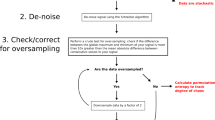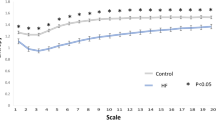Abstract
The electrical properties of the mammalian heart undergo many complex transitions in normal and diseased states1,2,3,4,5,6,7. It has been proposed that the normal heartbeat may display complex nonlinear dynamics, including deterministic chaos8,9, and that such cardiac chaos may be a useful physiological marker for the diagnosis10,11,12 and management13,14 of certain heart trouble. However, it is not clear whether the heartbeat series of healthy and diseased hearts are chaotic or stochastic15,16,17, or whether cardiac chaos represents normal or abnormal behaviour18. Here we have used a highly sensitive technique, which is robust to random noise, to detect chaos19. We analysed the electrocardiograms from a group of healthy subjects and those with severe congestive heart failure (CHF), a clinical condition associated with a high risk of sudden death. The short-term variations of beat-to-beat interval exhibited strongly and consistently chaotic behaviour in all healthy subjects, but were frequently interrupted by periods of seemingly non-chaotic fluctuations in patients with CHF. Chaotic dynamics in the CHF data, even when discernible, exhibited a high degree of random variability over time, suggesting a weaker form of chaos. These findings suggest that cardiac chaos is prevalent in healthy heart, and a decrease in such chaos may be indicative of CHF.
This is a preview of subscription content, access via your institution
Access options
Subscribe to this journal
Receive 51 print issues and online access
$199.00 per year
only $3.90 per issue
Buy this article
- Purchase on Springer Link
- Instant access to full article PDF
Prices may be subject to local taxes which are calculated during checkout






Similar content being viewed by others
References
Smith, J. M. & Cohen, R. J. Simple finite-element model accounts for wide range of cardiac dysrhythmias. Proc. Natl Acad. Sci. USA 81, 233–237 (1984).
Chialvo, D. R. & Jalife, J. Nonlinear dynamics of cardiac excitation and impulse propagation. Nature 330, 749–752 (1987).
Chialvo, D. R., Gilmour, R. F. & Jalife, J. Low-dimensional chaos in cardiac tissue. Nature 343, 653–657 (1990).
Jalife, J. Ann. NY Acad. Sci. 591((1990)).
Davidenko, J. M., Pertsov, R. S., Baxter, W. & Jalife, J. Stationary and drifting spiral waves of excitation in isolated cardiac muscle. Nature 355, 349–351 (1989).
Winfree, A. T. Electrical turbulence in three-dimensional heart muscle. Science 266, 1003–1006 (1994).
Glass, L. Dynamics of cardiac arrhythmias. Phys. Today 40–45 (1996).
Goldberger, A. L. Is the normal heartbeat chaotic or homeostatic? News Physiol. Sci. 6, 87–91 (1991).
Sugihara, G., Allan, W., Sobel, D. & Allan, K. D. Nonlinear control of heart rate variability in human infants. Proc. Natl Acad. Sci. USA 93, 2608–2613 (1996).
Denton, T. A., Diamond, G. A., Helfant, R. H., Khan, S. & Karagueuzian, H. Fascinating rhythm: A primer on chaos theory and its application to cardiology. Am. Heart J. 120, 1419–1440 (1990).
Skinner, J. E., Goldberger, A. L., Mayer-Kress, G. & Ideker, R. E. Chaos in the heart: Implications for clinical cardiology. Biotechnology 8, 1018–1024 (1990).
Goldberger, A. L. Nonlinear dynamics for clinicians: Chaos theory, fractals and complexity at the bedside. Lancet 347, 1312–1314 (1996).
Garfinkel, A., Spano, M. L., Ditto, W. L. & Weiss, J. N. Controlling cardiac chaos. Science 257, 1230–1235 (1992).
Garfinkel, A., Weiss, J. N., Ditto, W. L. & Spano, M. L. Chaos cotnrol of cardiac arrhythmias. Trends Cardiovasc. Med. 5, 76–80 (1995).
Kaplan, D. T. & Cohen, R. J. Is fibrillation chaos? Circ. Res. 67, 886–892 (1990).
Kanters, J. K., Holstein-Rathlou, N.-H. & Agner, E. Lack of evidence for low-dimensional chaos in heart rate variability. J. Cardiovasc. Electrophysiol. 5, 591–601 (1994).
Turcott, R. G. & Teich, M. C. Fractal character of the electrocardiogram: Distinguishing heart-failure and normal patients. Ann. Biomed. Eng. 24, 269–293 (1996).
Glass, L. Is cardiac chaos normal or abnormal? J. Cardiovasc. Electrophysiol. 1, 481–482 (1990).
Barahona, M. & Poon, C.-S. Detection of nonlinear dynamics in short, noisy time series. Nature 381, 215–217 (1996).
Peng, C. K., Havlin, S., Stanley, H. E. & Goldberger, A. L. Quantification of scaling exponents and crossover phenomena in nonstationary heartbeat time series. Chaos 5, 82–87 (1995).
Ivanov, P. C. et al. Scaling behaviour of heartbeat intervals obtained by wavelet-based time-series analysis. Nature 383, 323–327 (1996).
Goldberger, A. L., Rigney, D. R., Mietus, J., Antman, E. W. & Greenwald, S. Nonlinear dynamics in sudden cardiac death syndrome: heartrate oscillations and bifurcations. Experientia 44, 983–987 (1988).
Casolo, G., Balli, E., Taddei, T., Amuhasi, J. & Gori, C. Decreased spontaneous heart rate variability on congestive heart failure. Am. J. Cardiol. 64, 1162–1167 (1989).
Grebogi, C., Ott, E., Pelikan, S. & Yorke, J. A. Strange attractors that are not chaotic. Physica D 13, 261–268 (1984).
Pomeau, Y. & Manneville, P. Intermittent transition to turbulence in dissipative dynamical systems. Commun. Math. Phys. 74, 189–197 (1980).
Skinner, J. E., Pratt, C.-M. & Vybiral, T. A. Reduction in the correlation dimension of heartbeat intervals precedes imminent ventricular fibrillation in human subjects. Am. Heart J. 125, 731–743 (1993).
Acknowledgements
We thank A. L. Goldberger and R. G. Mark for discussions and comments on the manuscript, and A. L. Goldberger and J. E. Mietus for providing the heartbeat data. This work was supported by grants from the National Heart, Lung and Blood Institute, National Science Foundation, and Office of Naval Research.
Author information
Authors and Affiliations
Corresponding author
Rights and permissions
About this article
Cite this article
Poon, CS., Merrill, C. Decrease of cardiac chaos in congestive heart failure. Nature 389, 492–495 (1997). https://doi.org/10.1038/39043
Received:
Accepted:
Issue Date:
DOI: https://doi.org/10.1038/39043
This article is cited by
-
Temporal variations in the pattern of breathing: techniques, sources, and applications to translational sciences
The Journal of Physiological Sciences (2022)
-
Fusion Algorithm for Accurate Delineation of QRS Complex in ECG Signal
Circuits, Systems, and Signal Processing (2019)
-
Heartbeat Complexity Modulation in Bipolar Disorder during Daytime and Nighttime
Scientific Reports (2017)
-
Sensitivity of Chaos Measures in Detecting Stress in the Focusing Control Mechanism of the Short-Sighted Eye
Bulletin of Mathematical Biology (2017)
-
Wavelet-Based Multiscale Sample Entropy and Chaotic Features for Congestive Heart Failure Recognition Using Heart Rate Variability
Journal of Medical and Biological Engineering (2015)
Comments
By submitting a comment you agree to abide by our Terms and Community Guidelines. If you find something abusive or that does not comply with our terms or guidelines please flag it as inappropriate.



